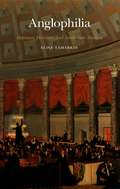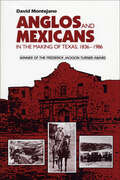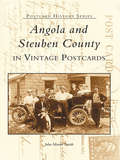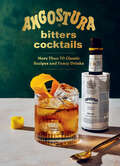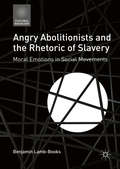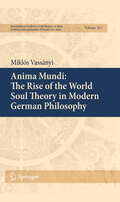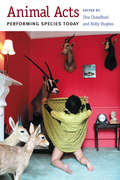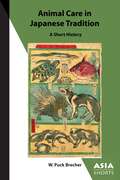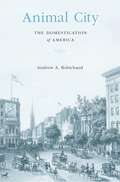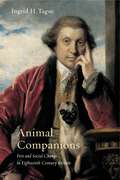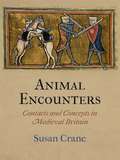- Table View
- List View
Anglomania
by Ian Buruma"Imaginative, original--wittily written."--The Washington Post Book WorldTo some, England has long represented tolerance, reason, and political moderation. To others, it is a moribund bastion of snobbery and outdated tradition. In this lively and diverting social history, noted author Ian Buruma, himself the son of Dutch immigrants to England, provides an incisive look at anglophilia--and anglophobia--over the last two centuries.From passionate enthusiasts like Voltaire and Goethe, to exiles like Garibaldi and Herzen, to colorful England-bashers like Napoleon, Marx, and Kaiser Wilhelm II, Anglomania gives a sharply satirical account of Europe's sometimes comical, sometimes deadly prejudices, and explains why England's individuality and her relationship with Europe is still vitally important as we enter the twenty-first century.
Anglophilia: Deference, Devotion and Antebellum America
by Elisa TamarkinAnglophilia charts the phenomenon of the love of Britain that emerged after the Revolution and remains in the character of U.S. society and class, the style of academic life, and the idea of American intellectualism. But as Tamarkin shows, this Anglophilia was more than just an elite nostalgia; it was popular devotion that made reverence for British tradition instrumental to the psychological innovations of democracy. Anglophilia spoke to fantasies of cultural belonging, polite sociability, and, finally, deference itself as an affective practice within egalitarian politics. Tamarkin traces the wide-ranging effects of Anglophilia on American literature, art and intellectual life in the early nineteenth century, as well as its influence in arguments against slavery, in the politics of Union, and in the dialectics of liberty and loyalty before the civil war. By working beyond narratives of British influence, Tamarkin highlights a more intricate culture of American response, one that included Whig elites, college students, radical democrats, urban immigrants, and African Americans. Ultimately, Anglophila argues that that the love of Britain was not simply a fetish or form of shame--a release from the burdens of American culture--but an anachronistic structure of attachment in which U.S. Identity was lived in other languages of national expression.
Anglos and Mexicans in the Making of Texas, 1836-1986
by David MontejanoThe author sets out to answer questions "that 'grew up' with me, questions about the Texas world I came to know as a fourth-generation native. The most prominent feature of this world was the sharp division between Anglo and Mexican in schools, neighborhoods, and social life generally. What were the origins of such segregation? And why, during the past twenty years, was this segregated order apparently breaking down?" -- from the Acknowledgements.<P> The author explains in the introduction that "two major concerns guided this work. One was to reconstruct a history of Mexican-Anglo relations in Texas 'since the Alamo.'" The "second major concern, then, was to ask this history some sociological questions about ethnicity, social change, and society itself." <P> Winner of the Frederick Jackson Turner Award
Anglos and Mexicans in the Making of Texas, 1836–1986
by David Montejano&“A benchmark publication . . . A meticulously documented work that provides an alternative interpretation and revisionist view of Mexican-Anglo relations.&” –IMR (International Migration Review) Winner, Frederick Jackson Turner Award, Organization of American Historians American Historical Association, Pacific Branch Book Award Texas Institute of Letters Friends of The Dallas Public Library Award Texas Historical Commission T. R. Fehrenbach Award, Best Ethnic, Minority, and Women&’s History Publication Here is a different kind of history, an interpretive history that outlines the connections between the past and the present while maintaining a focus on Mexican-Anglo relations. This book reconstructs a history of Mexican-Anglo relations in Texas &“since the Alamo,&” while asking this history some sociology questions about ethnicity, social change, and society itself. In one sense, it can be described as a southwestern history about nation building, economic development, and ethnic relations. In a more comparative manner, the history points to the familiar experience of conflict and accommodation between distinct societies and peoples throughout the world. Organized to describe the sequence of class orders and the corresponding change in Mexican-Anglo relations, it is divided into four periods, which are referred to as incorporation, reconstruction, segregation, and integration. &“The success of this award-winning book is in its honesty, scholarly objectivity, and daring, in the sense that it debunks the old Texas nationalism that sought to create anti-Mexican attitudes both in Texas and the Greater Southwest.&” —Colonial Latin American Historical Review &“An outstanding contribution to U.S. Southwest studies, Chicano history, and race relations . . . A seminal book.&” –Hispanic American Historical Review
Angola (The Evolution of Africa's Major Nations)
by Rob StaegerThe modern state of Angola was established in 1975, when it won its freedom from Portugal. However, peace did not accompany Angola's independence. Instead, fighting between nationalist groups launched the country into nearly three decades of civil war. Although the civil war ended a decade ago, its effects are still being felt. Angola's people are among the poorest in the world, and it is home to more land mines than any other country. Angola does have some advantages, including vast reserves of diamonds and oil. Angolans hope to use the wealth from these resources to rebuild their shattered society.
Angola and Steuben County in Vintage Postcards: In Vintage Postcards (Postcard History Series)
by John Martin SmithPast visitors to the famous lakes of Steuben County had a wide range of interesting images on postcards to send back home or to add to their collections. The favorite locations and activities of vacationers were chronicled in the postcards that have been passed down through generations.Featuring more than 200 vintage postcards, Angola and Steuben County captures fleeting images that reflect the interesting and significant scenes of Steuben County's towns and day-to-day activities at the turn of the century. From thriving squares and bustling industries, to pleasant residential and lake areas, these postcards embrace the past and offer a glimpse into the lives and activities of a different era.
Angola to Zydeco: Louisiana Lives
by R. Reese FullerAngola to Zydeco: Louisiana Lives is a collection of creative nonfiction pieces about the lively personalities who call south Louisiana home. Originally published in newspapers based in Lafayette—Times of Acadiana and Independent Weekly—the twenty-five profiles and features provide intriguing glimpses into the lives of well-known Louisianans such as James Lee Burke, Ernest J. Gaines, Elemore Morgan Jr., Buckwheat Zydeco, Marc Savoy, Boozoo Chavis, Calvin Borel, Santy Runyon, and Eddie Shuler. Author R. Reese Fuller also details the sometimes zany and sometimes tragic subjects that populate the cultural landscape of south Louisiana, from Tabasco peppers to Angola prison to cockfighting. Fuller brings years of experience in the newspaper industry to bear on this collection, offering behind-the-scenes access not available elsewhere. Of particular note are his interviews with musicians and local celebrities, who reveal how their love of the region has influenced their work. Fuller’s natural approach to storytelling creates a book that is a joy to read and truly represents the people of south Louisiana.
Angola: A Modern Military History, 1961-2002
by Stephen L. WeigertThis study is the first comprehensive assessment of warfare in Angola to cover all three phases of the nation's modern history: the anti-colonial struggle, the Cold War phase, and the post-Cold War era. It also covers, in detail, the final phase of warfare in Angola, culminating in Jonas Savimbi's death and the signing of the Luena Accord
Angolan War of Liberation: Colonial–Communist Clash, 1961–1974 (Cold War, 1945–1991)
by Al J. VenterWhen a large group of rebels invaded Angola from a recently independent Congo in 1961, it heralded the opening shots in another African war of independence. Between 1961 and 1974, Portugal faced the extremely ambitious task of conducting three simultaneous counterinsurgency campaigns to preserve its hegemony of Angola, Portuguese Guinea and Mozambique. While other European states were falling over themselves in granting independence to their African possessions, Portugal chose to stay and fight despite the odds against success.That it did so successfully for thirteen years in a distant multi-fronted war remains a remarkable achievement, particularly for a nation of such modest resources. For example, in Angola the Portuguese had a tiny air force of possibly a dozen transport planes, a squadron or two of F-86s and perhaps twenty helicopters: and that in a remote African country twice the size of Texas. Portugal proved that such a war can be won. In Angola victory was complete.However, the political leadership proved weak and irresolute, and this encouraged communist elements within the military to stage a coup in April 1974 and lead a capitulation to the insurgent movements, squandering the hard-won military and social gains and abandoning Portugals African citizens to generations of civil war and destitution.
Angostura Bitters Cocktails: More than 70 Classic Recipes and Fancy Drinks
by House of AngosturaRaise your glass to more than two centuries of delicious history and mixology. In 1824, Johann Siegert, surgeon general of Venezuela's army, created Angostura bitters as a medicinal tincture to alleviate soldiers' stomach ailments. Sailors soon discovered that adding it to gin helped quell seasickness, giving rise to the Pink Gin cocktail. Over time, this iconic concoction has gained worldwide popularity, becoming a key ingredient in countless drinks. This spirited collection celebrates that legacy with timeless classics; inventive twists on familiar favorites, including the Oaxaca Old-Fashioned, Rum Manhattan, and Mandarin Sazerac; as well as exciting new creations such as the Fitzgerald, Old Flame, and Scarlet Ibis. It also features nonalcoholic drinks such as the famous Lemon, Lime, and Bitters, along with ideas for incorporating bitters into culinary creations both sweet and savory. Alongside the delicious recipes, sidebars dive into the brand's fascinating history, including why the iconic label is too big for the bottle and how the company keeps the formula secret. Beautifully photographed and endlessly enticing, this book will delight any cocktail lover.
Angry Abolitionists and the Rhetoric of Slavery: Moral Emotions in Social Movements (Cultural Sociology)
by Benjamin Lamb-BooksThis book is an original application of rhetoric and moral-emotions theory to the sociology of social movements. It promotes a new interdisciplinary vision of what social movements are, why they exist, and how they succeed in attaining momentum over time. Deepening the dimension of cultural sociology, this work draws upon the social psychology of human emotion and interpersonal communication. Specifically, the book revolves around the topic of anger as a unique moral emotion that can be made to play crucial motivational and generative functions in protest. The chapters develop a new theory of the emotional power of protest rhetoric, including how abolitionist performances of heterodoxic racial and gender status imaginaries contributed to the escalation of the 'sectional conflict' over American slavery.
Angus L. Macdonald
by T. Stephen HendersonPerhaps one of the most influential Canadian premiers of the Twentieth Century and one of the leading political intellectuals of his generation, Angus L. Macdonald dominated politics in Nova Scotia for more than twenty years, serving as premier from 1933 to 1940 and again from 1945 until his death in 1954. One rival referred to him as "the pope" out of respect for his political infallibility. From 1940 to 1945 Macdonald guided Canada's war effort at sea as Minister of National Defence for Naval Services; under his watch, the Royal Canadian Navy expanded faster than any other navy in the world.This new work by T. Stephen Henderson is the first academic biography of Macdonald, whose life provides a framework for the study of Canada's pre- and post-war transformation, and a rare opportunity to compare the political history of the two periods. Generally, Macdonald's political thinking reflected a progressive, interwar liberalism that found its clearest expression in the 1940 Rowell-Sirois report on federal-provincial relations. The report proposed a redistribution of responsibilities and resources that would allow poorer provinces greater autonomy and reduce overlapping jurisdictions in the federal system. Ottawa abandoned Rowell-Sirois in the postwar period, and Macdonald fell out of step with the national Liberal party that he had once seemed destined to lead. Within Nova Scotia, however, his ardent defence of provincial powers and his commitment to building a modern infrastructure enabled him to win election after election and transform the face and identity of his province.
Angéline de Montbrun: A Psychological Romance of Quebec
by Laure Conan Yves BrunelleLaure Conan was the first woman novelist in French Canada and the first writer in all Canada to attempt a roman d'analyse. As she refused to have her true identity revealed, the author of the preface to her book, Abbé H.-R. Casgrain, made a point of confirming that it was indeed a woman hiding behind the pen-name. Her daring in writing a psychological novel was 'forgiven' because she was a woman, and her anticipating the trend towards this type of novel was attributed to 'that intuition natural to her sex.' In Angéline de Montbrun, Laure Conan broke with what has been called the 'collective romanticism' of nineteenth-century French-Canadian land, with the rural myth, the exhortative tone, and the vast canvas. These concerns are basically absent in her work. Further, she eschewed the details of adventure and intrigue, the wooden, predictable characters, and the transparent intricacies of romantic love in favour of writing about the inner turmoil of an individual, live character, a young woman caught in a complex web of human appetites, aspirations, and relationships. Because of the novel's realism, one of the most persistent topics of discussion about Laure Conan has been whether or not Angéline de Montbrun is autobiographical. Recent studies indicate it may be. In any case, Angéline was the most complex character in Canadian fiction to 1882 and for some time to come. Traditionally, Angéline de Montbrun was regarded as a novel of Christian renunciation, and Angéline as the most holy of heroines. For a long time no one went too deeply into the relationships between the characters, but in 1961 Jean Le Moyne bluntly stated that 'the lovers in the novel are not Maurice Darville and Angéline, but M. de Montbrun and his daughter.' Since then there has been a proliferation of interpretations and psychological studies of the novel, and there is no going back to the simpler view of it.
Angélique
by Lorena Gale"And in seventeen thirty-four a Negro slave set fire to the City of Montreal and was hanged..." With this bald statement of history as a basis, Lorena Gale constructs a vivid portrait of a time when captive people had no say in the outcome of their lives. A rich, poetic evocation of a graceful yet cruel time—a time when “civilized” citizens still bought and sold slaves. This is a time when the thoughts and feelings of these captive people had no bearing on the outcome of their lives, unless they were outraged and brave enough to try and shake their bonds. Angélique is the winner of the du Maurier National Playwriting Competition and was nominated Outstanding New Play in Calgary’s Betty Mitchell Awards, 1998.
Aniela Kaminski's Story: A Voyage from Poland during World War II (Journey to America Series)
by Clare PastoreThey left their homelands during the worst moments in history and arrived in America ready to reach for their dreams. These are their stories... Dear Jadzia,I thought Papa and I would never make it out of Poland. I was afraid the Nazis would find us and send us to jail. After Stefan was arrested, I knew it could happen to us, too. Do you have any news of him? I hope and pray that he is safe. And Edith, too. It makes me angry to think that people hate her just because she is Jewish. You would love America. Life is so much better here. We are staying with my aunt and uncle in a city called Chicago, and there is lots of good food to eat. And guess what? I might even start taking piano lessons again! I wish you were here, Jadzia. I miss you so very much... Your friend, Aniela
Anima Mundi: The Rise Of The World Soul Theory In Modern German Philosophy (International Archives of the History of Ideas Archives internationales d'histoire des idées #202)
by Miklós VassányiThis work presents and philosophically analyzes the early modern and modern history of the theory concerning the soul of the world, anima mundi. The initial question of the investigation is why there was a revival of this theory in the time of the early German Romanticism, whereas the concept of the anima mundi had been rejected in the earlier, classical period of European philosophy (early and mature Enlightenment). The presentation and analysis starts from the Leibnizian-Wolffian school, generally hostile to the theory, and covers classical eighteenth-century physico-theology, also reluctant to accept an anima mundi. Next, it discusses early modern and modern Christian philosophical Cabbala (Böhme and Ötinger), an intellectual tradition which to some extent tolerated the idea of a soul of the world. The philosophical relationship between Spinoza and Spinozism on the one hand, and the anima mundi theory on the other is also examined. An analysis of Giordano Bruno's utilization of the concept anima del mondo is the last step before we give an account of how and why German Romanticism, especially Baader and Schelling asserted and applied the theory of the Weltseele. The purpose of the work is to prove that the philosophical insufficiency of a concept of God as an ens extramundanum instigated the Romantics to think an anima mundi that can act as a divine and quasi-infinite intermediary between God and Nature, as a locum tenens of God in physical reality.
Animal Acts: Configuring the Human in Western History
by Jennifer Ham Matthew SeniorAnimal Acts records the history of the fluctuating boundary between animals and humans as expressed in literary, philosophical and scientific texts, as well as visual arts and historical practices such as dissection, circus acts, the hunt and zoos. The essays document a persistent return of animality, a becoming animal that has always existed within and at the margins of Western Culture from the Middle Ages to the present.
Animal Acts: Performing Species Today
by Holly Hughes Una ChaudhuriWe all have an animal story--the pet we loved, the wild animal that captured our childhood imagination, the deer the neighbor hit while driving. While scientific breakthroughs in animal cognition, the effects of global climate change and dwindling animal habitats, and the exploding interdisciplinary field of animal studies have complicated things, such stories remain a part of how we tell the story of being human. Animal Acts collects eleven exciting, provocative, and moving stories by solo performers, accompanied by commentary that places the works in a broader context. Work by leading theater artists Holly Hughes, Rachel Rosenthal, Deke Weaver, Carmelita Tropicana, and others joins commentary by major scholars including Donna Haraway, Jane Desmond, Jill Dolan, and Nigel Rothfels. Una Chaudhuri's introduction provides a vital foundation for understanding and appreciating the intersection of animal studies and performance. The anthology foregrounds questions of race, gender, sexuality, class, nation, and other issues central to the human project within the discourse of the "post human," and will appeal to readers interested in solo performance, animal studies, gender studies, performance studies, and environmental studies.
Animal Care in Japanese Tradition: A Short History
by W. Puck BrecherThis volume provides an historical overview of Japan's relationship with animals from ancient times to the 1950s. Its analysis serves as a lens through which to scrutinize Japanese tradition and interrogate ahistorical claims about Japan’s culturally endemic empathy for the natural world. Departing from existing scholarship on the subject, the book also connects Japan’s much-maligned record of animal exploitation with its strong adherence to contextual, needs-based moral memory.
Animal City: The Domestication of America
by Andrew A. RobichaudAmerican urbanites once lived alongside livestock and beasts of burden. But as cities grew, human–animal relationships changed. The city became a place for pets, not slaughterhouses or working animals. Andrew Robichaud traces the far-reaching consequences of this shift—for urban landscapes, animal- and child-welfare laws, and environmental justice.
Animal Companions: Pets and Social Change in Eighteenth-Century Britain (Animalibus)
by Ingrid H. TagueAnimal Companions explores how eighteenth-century British society perceived pets and the ways in which conversation about them reflected and shaped broader cultural debates.While Europeans kept pets long before the eighteenth century, many believed that doing so was at best frivolous and at worst downright dangerous. Ingrid Tague argues that for Britons of the eighteenth century, pets offered a unique way to articulate what it meant to be human and what society ought to look like. With the dawn of the Enlightenment and the end of the Malthusian cycle of dearth and famine that marked previous eras, England became the wealthiest nation in Europe, with a new understanding of religion, science, and non-European cultures and unprecedented access to consumer goods of all kinds. These transformations generated excitement and anxiety that were reflected in debates over the rights and wrongs of human-animal relationships.Drawing on a broad array of sources, including natural histories, periodicals, visual and material culture, and the testimony of pet owners themselves, Animal Companions shows how pets became both increasingly visible indicators of spreading prosperity and catalysts for debates about the morality of the radically different society emerging in eighteenth-century Britain.
Animal Companions: Pets and Social Change in Eighteenth-Century Britain (Animalibus: Of Animals and Cultures #6)
by Ingrid H. TagueAnimal Companions explores how eighteenth-century British society perceived pets and the ways in which conversation about them reflected and shaped broader cultural debates. While Europeans kept pets long before the eighteenth century, many believed that doing so was at best frivolous and at worst downright dangerous. Ingrid Tague argues that for Britons of the eighteenth century, pets offered a unique way to articulate what it meant to be human and what society ought to look like. With the dawn of the Enlightenment and the end of the Malthusian cycle of dearth and famine that marked previous eras, England became the wealthiest nation in Europe, with a new understanding of religion, science, and non-European cultures and unprecedented access to consumer goods of all kinds. These transformations generated excitement and anxiety that were reflected in debates over the rights and wrongs of human-animal relationships.Drawing on a broad array of sources, including natural histories, periodicals, visual and material culture, and the testimony of pet owners themselves, Animal Companions shows how pets became both increasingly visible indicators of spreading prosperity and catalysts for debates about the morality of the radically different society emerging in eighteenth-century Britain.
Animal Electricity: How We Learned That the Body and Brain Are Electric Machines
by Robert B. CampenotLike all cellular organisms humans run on electricity. Cells work like batteries: slight imbalances of electric charge across cell membranes, caused by ions moving in and out of cells, result in sensation, movement, awareness, and thinking--the things we associate with being alive. Robert Campenot offers an accessible overview of animal electricity.
Animal Encounters
by Susan CraneTraces of the living animal run across the entire corpus of medieval writing and reveal how pervasively animals mattered in medieval thought and practice. In fascinating scenes of cross-species encounters, a raven offers St. Cuthbert a lump of lard that waterproofs his visitors' boots for a whole year, a scholar finds inspiration for his studies in his cat's perfect focus on killing mice, and a dispossessed knight wins back his heritage only to give it up again in order to save the life of his warhorse. Readers have often taken such encounters to be merely figurative or fanciful, but Susan Crane discovers that these scenes of interaction are firmly grounded in the intimate cohabitation with animals that characterized every medieval milieu from palace to village. The animal encounters of medieval literature reveal their full meaning only when we recover the living animal's place within the written animal.The grip of a certain humanism was strong in medieval Britain, as it is today: the humanism that conceives animals in diametrical opposition to humankind. Yet medieval writing was far from univocal in this regard. Latin and vernacular works abound in other ways of thinking about animals that invite the saint, the scholar, and the knight to explore how bodies and minds interpenetrate across species lines. Crane brings these other ways of thinking to light in her readings of the beast fable, the hunting treatise, the saint's life, the bestiary, and other genres. Her substantial contribution to the field of animal studies investigates how animals and people interact in culture making, how conceiving the animal is integral to conceiving the human, and how cross-species encounters transform both their animal and their human participants.
Animal Farm
by George Orwell Russell Baker C. M. WoodhouseRevisit Orwell’s 1946 classic satire Animal Farm As ferociously fresh as it was more than a half century ago, this remarkable allegory of a downtrodden society of overworked, mistreated animals and their quest to create a paradise of progress, justice, and equality is one of the most scathing satires ever published. As readers witness the rise and bloody fall of the revolutionary animals, they begin to recognize the seeds of totalitarianism in the most idealistic organization—and in the most charismatic leaders, the souls of the cruelest oppressors. Note: Does not use standard American spellings.

